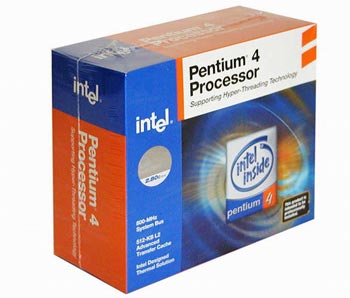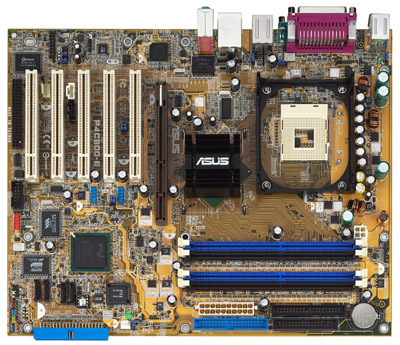Overclocking Buyer's Guide - August 2004
by Wesley Fink on July 27, 2004 11:24 AM EST- Posted in
- Guides
CPU and Motherboard: VALUE OC Recommendations
CPU: Intel Pentium 4 2.8C 800MHz FSB Northwood (512K L2 cache)Motherboard: ASUS P4C800-E Deluxe (875P chipset)
Price: CPU - $175 shipped (Retail). Motherboard - $172 shipped
Choosing an Intel processor these days can be very confusing, as there are so many flavors available. Because the Intel processors are multiplier locked, we like the 2.8 speed for overclocking. The 14 multiplier is realistic for reaching the best overclocks that you will likely achieve with a Pentium 4. The question becomes, "which 2.8?" The 2.8A is based on the Prescott core, but is without Hyperthreading and runs with a 21 multiplier at a 533 FSB. While we have seen reports of these CPUs reaching 180 to 190 overclocks (3.78GHz to 4.0GHz), we are still left with the diminishing returns of a high multiplier, a FSB below 800, and no Hyperthreading. If the 2.8A were cheaper than the 2.8E or C, we could easily recommend it, but at about the same price, we would choose an 800FSB 2.8.

With the Prescott 2.8E at the same price as the Northwood 2.8C, the 2.8C is an easy choice unless you have to have the highest FSB for bragging rights. On Socket 478, Northwood performs better than Prescott, and you will also likely find that the overclocked Northwood, which will top out about 3.4 to 3.7GHz, is still a better performer than the overclocked Prescott on the 875 chipset and Socket 478. The 2.8C runs at 800MHz FSB with a 14X multiplier. This multiplier should allow you to squeeze everything from the Northwood Pentium 4 that you can get. 3.7GHz would require a doable 265 Clock frequency, and the more likely 3.5GHz can be achieved at 250FSB, which is DDR500 at 1:1 memory.
It's been several months since we did some serious overclocking with a Northwood chip, but reports are that recent Northwoods are overclocking very well. Our Evan Lieb reached 3.4GHz with default 1.525 voltage, with a 2.8C on a P4C800-E motherboard. With voltage cranked to 1.65V, he reached a very stable 3.59GHz, which proved its stability by running 8 hours+ looping Prime95 and SPECviewperf 7.1.1 programs. Chips and performance do vary and overclocking is never guaranteed, but the performance that we have seen with off-the-shelf 2.8C processors suggest that you can and should be able to reach the highest levels of Northwood performance with a 2.8C and a motherboard that overclocks very well.

When all is said and done, the P4C800-E Deluxe has proven itself to be the premier Pentium 4 motherboard for overclockers. This motherboard has reached 290+ in our DDR memory test bed, and we have seen 270MHz-280MHz FSB using just basic retail Intel cooling with a good 2.4C processor. With a 2.8C processor, you should be able to run fast memory at 1:1 to the fastest processor speed that you can reach. You also have the option of running fast DDR400 memory at 2-2-2 timings, at a lower ratio, which is often just as fast as higher memory speeds at higher latencies. With all things being equal, higher memory speed is faster, but higher memory speed often requires higher latencies. Which is better depends on how aggressive your timings can be at the highest memory speed.
However you cut it, though, the ASUS P4C800-E Deluxe offers everything an overclocker could want: plenty of room for FSB overclocking, 2.85V max VDIMM, 1.95V max Vcore, and features like CSA Gigabit LAN, SATA and IDE RAID, IEEE 1394 FireWire, etc. This motherboard is absolutely packed with just about every feature that a high end user and overclocker could need.
Listed below is part of our RealTime pricing engine, which lists the lowest prices available on Intel motherboards from many different reputable vendors:
If you cannot find the lowest prices on the products that we've recommended on this page, it's because we don't list some of them in our RealTime pricing engine. Until we do, we suggest that you do an independent search online at the various vendors' web sites. Just pick and choose where you want to buy your products by looking for a vendor located under the "Vendor" heading.










40 Comments
View All Comments
rwinder - Tuesday, August 3, 2004 - link
I think it is a wonderful guide. Kudos for having the nads to do it, knowing that there would be "experts" that would give you crap about your recommendations. Don't let them deter you.One suggestion: Could you benchmark the performance of your recommendations (and alternatives) so us readers can make the price/value judgements?
mindless1 - Monday, August 2, 2004 - link
Seems kinda like we had to read whole article to get to the end, no?The point is, primary suggested parts were NOT appropriate for a "value o'c" system. Value does not mean merely not to choose most expensive parts in one or two areas. FOr the described value system there would be zero benefit to spending the extra $150 (over what needed spec parts would cost) on fancier case/PSU, and only a half-dozen %, at best difference in memory costing twice as much... that's not value at all, it's much higher than avg cost for new system in the market today.
lazerasa - Monday, August 2, 2004 - link
You people whining about the case, memory, and video card on the value selections... read the systems summary page, there are other, cheaper recommendations there. Read the whole artice before you start your whining.mindless1 - Monday, August 2, 2004 - link
CM Stacker is a nice case but c'mon, who's going to build a value o'c system and spend $262 on case + PSU?Likewise, someone would have to be kinda stupid to spend $300-odd $ on high end memory for the value o'c system unless /required/ by the particular 'board just to get 1GB or more stable. Other suggested systems would be a more appropriate platform for that memory.
BTW, the OCZ 520W PSU is not all that great. It IS fancy, but the base design (including after the cosmetic tweaks) cannot support 520W. Sadly it may be no better than a Sparkle 350W yet priced 3X higher. Don't be fooled by a $3 big anodized heatsink or "good" reviews where they don't subject it to a heavy load... after all that was the whole point of 520W, no? TO someone who knows PSU, it only takes a very short glance at that PSU to know why it can't support 520W.
cnq - Saturday, July 31, 2004 - link
Wesley,I agree with many of the comments: we may not agree with all your picks, but we really like the enthusiasm and obvious energy that you've poured into your picks and your writeup.
Now for a little more feedback :)
There wasn't any "value" video card pick.
Was that intentional, or an oversight? I can understand that the next gen vid cards are *so* far ahead in performance that you would urge your readers to spring for one, but still it seems that you should toss in a value pick.
So, thinking of the Athlon2500 buyer who (presumably) can't spring $400 for a next-gen vid card, what would you recommend in the $175-$199 price range? My picks would be a 9800pro followed by a 5900XT. (True, the 5900XT was born to overclock [390-->500 seems the norm ], but that doesn't mean it catches up to an overclocked 98pro in absolute performance.)
rjm55 - Saturday, July 31, 2004 - link
29 and WesleyThanks for clearing up the Athlon XP mobile info. I was a bit confused with the difference in the specs with desktop Barton, but now its clear. If you gotta have a XP, it looks like the 2600+ Mobile is now the one to get.
Wesley Fink - Friday, July 30, 2004 - link
#29 - You are correct and I actually do know better. The multipliers and FSB have been corrected in the Athlon XP section on page 6.#31, #32, and #33 - I fully understand that many look at overclocking to bring more value to their computer buying. There are also others who use overclocking to bring new performance highs to their computer platform. As I stated in the review, these 2 goals are often at odds. That is exactly the reason I have done BOTH Performance OC and Value OC recommendations and alternates.
If Value is your main OC concern, then throw all the rocks you like at my Value picks, but please don't assume the Performance OC buyers don't exist or don't matter. I can assure you from emails and discussions on Forums that Performance OC is also an important concern for many buyers who OC their systems.
WheelsCSM - Thursday, July 29, 2004 - link
I agree with Z80. While I understand that different people view value differently, I can't see how a $390 video card or $175 case can be considered value in anyone's book. Other than that, I think this was an excellent article, and I look forward to future overclocking system recommendations.Z80 - Thursday, July 29, 2004 - link
I'd say that most of your readers, like me, see overclocking as just another means to squeeze more "bang-for-the-buck" out of our PC dollars. We like to run well in the benchmarks but at the same time spend half of what a typical Dell customer might spend for the same performance. In my opinion, you missed your "Value OC" goal by a mile. If it wan't for your last statement "go with a cheaper case for $100 less. Second, buy an ATI 9800 PRO for $200 less and overclock the heck out of it. Third, go for one of the CAS 2.5 value DDR400 memories from Corsair, Geil, OCZ, Kingston, and others; this could save you about $125. These three substitutions reduce the price by $425 and get the core system price down to $836" Maybe you should look at factoring in a bang-for-your-buck cost comparison factor like you did with a recent video card review.Z80 - Thursday, July 29, 2004 - link
I'd say that most of your readers, like me, see overclocking as just another means to squeeze more "bang-for-the-buck" out of our PC dollars. We like to run well in the benchmarks but at the same time spend half of what a typical Dell customer might spend for the same performance. In my opinion, you missed your "Value OC" goal by a mile. If it wan't for your last statement "go with a cheaper case for $100 less. Second, buy an ATI 9800 PRO for $200 less and overclock the heck out of it. Third, go for one of the CAS 2.5 value DDR400 memories from Corsair, Geil, OCZ, Kingston, and others; this could save you about $125. These three substitutions reduce the price by $425 and get the core system price down to $836" Maybe you should look at factoring in a bang-for-your-buck cost comparison factor like you did with a recent video card review.